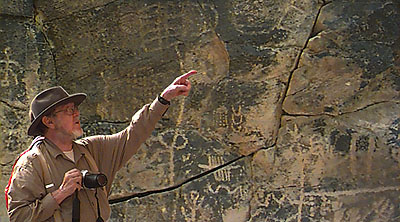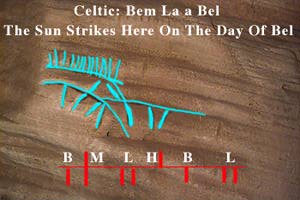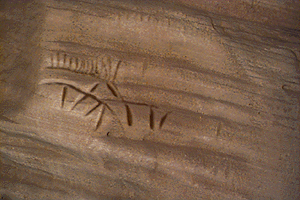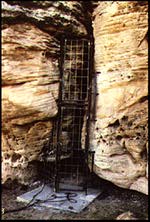|
by Gary Vey for ViewZone
The idea that he had discovered evidence of ancient Europeans and Asians in the panhandle of Oklahoma was not unusual to Bill McGlone. He spent the better part of his life examining and researching the petroglyphs that were etched into the cliffs, peaks and caves all around his home in La Junta, Colorado.
 I first met Bill when I visited La Junta to explore the possibility that an Arabic language, now extinct for millennia, was mingled with the etchings and doodling of the Plains Indians. My first impression was that he looked like Burl Ives and had the gentle friendliness of Captain Kangaroo. He was too weak to rise from his chair and I was soon to learn that his health would not permit his guidance when we examined the petroglyphs. Bill was an engineer and a scientist. He quickly turned the misfortune of his illness into a more "empirical and objective" way for the ViewZone feature to be researched. Bill had drawn a detailed map of the entire region with landmarks and arrows pointing to a cliff and "Look here." Much of the passage was through cattle that were grazing in huge acreage that was bordered every mile by dirt streets numbering, "26, 25, 24...etc.," and, "G, H, I..." My little Geo Prism would have made a brilliant star in some Marlborough, macho commercial. But the map did its work and I finally located a remote part of the National Grasslands and followed the arrows to a narrow cave.
The area was boxed in by high canyons on three sides. There was a sandy river running through the central flat courtyard and the many petroglyphs were etched into the cliff walls, facing this courtyard. These can be viewed in a previously posted story about Picket Wire Canyon. In the midst of one of these cliff walls there was a crack about sixteen feet high and about two feet at the widest point. Once you squeezed through the narrow opening, the cave didn't open up much more. It's walls were smooth and ran almost parallel until they narrowed to a pile of rubble about thirty feet inside the cave. With all the markings on the cliffs surrounding it, this smooth rock was unblemished except for two unusual group of lines. The first was etched along a protrusion or bump on the otherwise linear wall. The other group of lines was located directly across from this bump. These lines were different from the Plains Indian markings and symbols. Bill McGlone has copied and studied these lines with the conclusion that they were, in fact, a written language called Ogam. Bill explained that Celtics had a way of communicating with hand signs and that they often would write these signs to spell messages in rock or wood. A horizontal line was first drawn. Then vertical lines were arranged in groups, either above or below the line, or both. These vertical lines represented the position of the fingers, either raised or bent, or missing. By examining the group of lines in this cave, Bill had deciphered both messages, using old Celtic phonetics.
 Not only do the lines translate into old Celtic, but the translation is verified by the concurrence of the alignment with the sun.
The first inscription read, "[We are the] People of the Sun." And the inscriptions on the bump, protruding from the flat wall read, "On the day of Bel, the sun will strike here."

Only on the Summer Equinox is the inscription illuminated by the rising sun in a way that suggests it was intentionally carved to mark this important day of the year.
This would have been enough for most explorers but Bill was also a scientist. He discovered that the "day of Bel" -- or Balentine, was the Summer Equinox, on June 21st. Bill and some companions stakes out the cave many days prior to the Equinox and watched the sun's rays angle a shaft of morning light through the Eastern facing cave. The pattern was different every morning but there was no illumination of the bump. Then, on the morning of the Equinox, Bill and his friends witnessed and photographed the rays of light fully illuminating the inscription.
This may not prove Bill's case though. The interior of the cave, although very old, is protected from the patina that usually forms on rock surfaces exposed to the elements and assists in determining age. If these are Ogam, they could have been placed here at any time by someone with the knowledge of Celtic. The face that there is little Native American inscriptions in the cave may suggest that either the cave was somehow blocked or that the symbols pre-dated the Indians and were respected as sacred.
Of course, there are many other possibilities. It could be, as Bill conjectured, that explorers came up the Mississippi and followed the river system clear to the base of the Rocky Mountains. Perhaps they camped in the area for a while and then moved on. Or maybe they are buried somewhere in the canyon.
Bill McGlone is sadly gone now. His work is largely abandoned as traditional academics always scowled at Bill's tenacity and creative thinking. If I had not seen the mile upon mile of ancient petroglyphs, in a writing system far different from traditional Native Americans, I would be able to let go of Bill's ideas. But I have seen them. They are right now out in the hot Colorado sun, being worn and tarnished by the elements, once more free to hide the untidy bits of history that just might reveal something about ourselves that we didn't know...
|

Other history related articles on this site:
.
.
.
.
.
.
.
.
.
.
.
.
If you have a suggestion or history related article to submit, send it to:
Editor/viewzone.com
myristicin@hotmail.com
 Since Bill's discovery, the Park Service has been moved to protect the cave from vandalism. An iron cage has been erected to block the entrance and the cave can only be accessed with a key from the local Park Ranger. Luckily for us, Bill had secured the key in advance. We were able to enter the cave and set up our camera equipment to capture the anticipated spectacle.
Since Bill's discovery, the Park Service has been moved to protect the cave from vandalism. An iron cage has been erected to block the entrance and the cave can only be accessed with a key from the local Park Ranger. Luckily for us, Bill had secured the key in advance. We were able to enter the cave and set up our camera equipment to capture the anticipated spectacle.